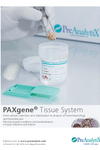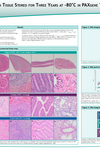Performance
Total DNA isolated with the PAXgene Tissue DNA Kit is highly pure. DNA has A260/A280 ratios of 1.7–1.9, and absorbance scans show a symmetrical peak at 260 nm, confirming high purity of genomic DNA. Contamination is minimal and purified DNA is ready to be used in downstream applications with no detectable inhibition of PCR (Figure 1 and Figure 2).
Principle
The PAXgene Tissue DNA Kit enables purification of DNA from tissues fixed and stabilized using the PAXgene Fixation and Stabilization reagents, which preserve tissue morphology and biomolecule integrity by avoiding destructive crosslinking and degradation found in formalin-fixed tissues. The purified DNA has no inhibitory chemical modifications and thus, can be used in sensitive downstream applications.
Procedure
PAxgene Tissue-fixed (PF) or PAXgene Tissue-fixed, paraffin-embedded (PFPE) tissue samples are lysed in Buffer TD1 with proteinase K. Conditions are adjusted for optimal binding of DNA to the silica membrane and the lysate is loaded on the PAXgene DNA spin column. DNA binds to the membrane while contaminants pass through. Enzyme inhibitors are effectively removed with subsequent washes and pure DNA is eluted in a low-salt elution buffer (Figure 3).
The PAXgene Tissue DNA Kit provides 2 protocols for purification of DNA from different starting materials:
- Sections of PFPE tissue
- PF tissue samples (without paraffin embedding)
Automation
DNA purification using the PAXgene Tissue DNA Kit can be automated on the QIAcube, enabling:
- Elimination of manual processing steps
- Elimination of up to 75% hands-on time compared to manual processing (Figure 4)
- Processing of up to 12 samples per run
- Processing of normal, fibrous or fat-rich PAXgene Tissue-fixed samples (Figure 5)
- Processing of 2–5 sections of PFPE tissue samples (Figure 8)
Two protocols are available for automated purification from different starting materials:
- DNA from PFPE tissue sections
Starting with pellets of 2–5 deparaffinized PFPE tissue sections - DNA from tissue samples fixed and stabilized in a PAXgene Tissue FIX Container
Starting with lysates from up to 10 mg fixed and stabilized tissue, homogenized in lysis buffer TD1
Applications
The purified DNA is ready to use in a wide range of downstream applications (see Resources), including:
- PCR, multiplex, long-range, and quantitative, real-time PCR
- Southern blotting
- SNP genotyping
- Next-generation sequencing (NGS)



























